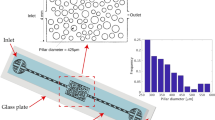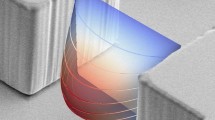Abstract
The development of an experimental protocol to investigate the flow field produced by the interaction of two immiscible liquids flowing through a porous network is reported. The experimental protocol allows simultaneous quantification of the velocity distribution in a multi-liquid system based on the microscopic particle image velocimetry technique. The experimental challenges associated with this unique application are discussed, including two-liquid imaging and interface tracking, and solutions that couple refractive index matching and fluorescent signal separation are described. The technique was applied to both single- and two-liquid flows in a two-dimensional pore network comprising a staggered array of circular pillars wherein the flow was driven by a steady pressure gradient. Both drainage and imbibition were considered herein with a focus on fluid–fluid front migration and effects owing to the passage of the interface. The velocity distribution obtained for these two-liquid-phase flow scenarios revealed several peculiarities when compared to the reference case of single-liquid-phase flow. In particular, the instabilities associated with the interfacial processes propagate downstream and perturb the flow field, resulting in dramatic differences from the regular and periodic flow paths typical of steady-state, single-phase flow. Additionally, the passage of the interface does not restore previous flow patterns, but instead yields complex preferential flow paths that mutually interact with residual trapped pockets of fluid. Such dynamical events must be quantified in order to properly model the pore-scale physics central to fully understanding the wealth of practical applications represented by this model flow system.













Similar content being viewed by others
References
Acharya RC, Valocchi AJ, Werth CJ, Willingham TW (2007) Pore-scale simulation of dispersion and reaction along a transverse mixing zone in two-dimensional porous media. Water Resour Res 43:W10435. doi:10.1029/2007WR005969
Adrian RJ, Westerweel J (2011) Particle Image Velocimetry, vol 30. Cambridge University Press, Cambridge
Armstrong RT, Berg S (2013) Interfacial velocities and capillary pressure gradients during Haines jumps. Phys Rev E 88:043010
Armstrong RT, Porter ML, Wildenchild D (2012) Linking pore-scale interfacial curvature to column-scale capillary pressure. Adv Water Resour 46:55–62
Berg S, Ott H, Klapp SA, Schwing A, Neiteler R, Brussee N et al (2013) Real-time 3D imaging of Haines jumps in porous media flow. Proc Natl Acad Sci 110(10):3755–3759
Corapcioglu MY, Yoon S, Chowdhury S (2009) Pore-scale analysis of NAPL blob dissolution and mobilization in porous media. Transp Porous Media 79(3):419–442
Crawford FW, Hoover GM (1966) Flow of fluids through porous mediums. J Geophys Res 71(12):2911–2917
Datta SS, Ramakrishnan TS, Weitz DA (2013) Mobilization of a trapped non-wetting fluid from a three-dimensional porous medium. Phys Fluids (1994–present) 26(2):022002
Di Carlo DA (2013) Stability of gravity-driven multiphase flow in porous media: 40 years of advancements. Water Resour Res 49(8):4531–4544
DiCarlo DA, Cidoncha JI, Hickey C (2003) Acoustic measurements of pore-scale displacements. Geophys Res Lett 30(17):2003. doi:10.1029/2003GL017811
Dijkhuizen W, Roghair I, Annaland M, Kuipers JAM (2010) DNS of gas bubbles behaviour using an improved 3D front tracking model—model development. Chem Eng Sci 65(4):1427–1437
Ferrari A, Lunati I (2013) Direct numerical simulations of interface dynamics to link capillary pressure and total surface energy. Adv Water Resour 57:19–31
Haines WB (1930) Studies in the physical properties of soil. V. The hysteresis effect in capillary properties, and the modes of moisture distribution associated therewith. J Agric Sci 20(01):97–116
Heyes DM, Baxter J, Tüzün U, Qin RS (2004) Discrete-element method simulations: from micro to macro scales. Philos Trans A 362(1822):1853
Hlushkou D, Tallarek U (2006) Transition from creeping via viscous-inertial to turbulent flow in fixed beds. J Chromatogr A 1126(1):70–85
Huppert HE, Neufeld JA (2014) The fluid mechanics of carbon dioxide sequestration. Annu Rev Fluid Mech 46:255–272
Jerauld GR, Salter SJ (1990) The effect of pore-structure on hysteresis in relative permeability and capillary pressure: pore-level modeling. Transp Porous Media 5:103–151
Jolls KR, Hanratty TJ (1966) Transition to turbulence for flow through a dumped bed of spheres. Chem Eng Sci 21(12):1185–1190
Kazemifar F, Kyritsis DC (2014) Experimental investigation of near-critical CO2 tube-flow and Joule–Thompson throttling for carbon capture and sequestration. Exp Therm Fluid Sci 53(2014):161–170
Kim BJ, Liu YZ, Sung HJ (2004) Micro PIV measurement of two-fluid flow with different refractive indices. Meas Sci Technol 15:1097–1103
Krishnamurthy S, Yoav P (2007) Gas–liquid two-phase flow across a bank of micropillars. Phys Fluids (1994–present) 19(4):043302
Krummel AT, Datta SS, Münster S, Weitz DA (2013) Visualizing multiphase flow and trapped fluid configurations in a model three-dimensional porous medium. AIChE J 59(3):1022–1029. doi:10.1002/aic.14005
Lenormand R, Zarcone C, Sarr A (1983) Mechanisms of the displacement of one fluid by another in a network of capillary ducts. J Fluid Mech 135:337–353
Lenormand R, Touboul E, Zarcone C (1988) Numerical models and experiments on immiscible displacements in porous media. J Fluid Mech 189:165–187
Liu H, Valocchi AJ, Kang Q, Werth C (2013) Pore-scale simulations of gas displacing liquid in a homogeneous pore network using the lattice Boltzmann method. Transp Porous Media 99(3):555–580
MacMinn C, Szulczewski M, Juanes R (2010) CO2 migration in saline aquifers. Part 1. Capillary trapping under slope and groundwater flow. J Fluid Mech 662:329–351
Meakin P, Tartakovsky AM (2009) Modeling and simulation of pore scale multiphase fluid flow and reactive transport in fractured and porous media. Rev Geophys 47:RG3002
Moebius F, Or D (2012) Interfacial jumps and pressure bursts during fluid displacement in interacting irregular capillaries. J Colloid Interface Sci 377(1):406–415
Moebius F, Canone D, Or D (2012) Characteristics of acoustic emissions induced by fluid front displacement in porous media. Water Resour Res. doi:10.1029/2012WR012525
Mohanty KK, Davis HT, Scriven LE (1987) Physics of oil entrapment in water-wet rock. SPE Reserv Eng 2(1):113–128
Natrajan VK, Christensen KT (2007) microscopic particle image velocimetry measurements of transition to turbulence in microscale capillaries. Exp Fluids 43(1):1–16
Natrajan VK, Christensen KT (2009) Two-color laser-induced fluorescent thermometry for microfluidic systems. Meas Sci Technol 20(1):015401
Natrajan VK, Yamaguchi E, Christensen KT (2007) Statistical and structural similarities between micro- and macro-scale wall turbulence. Microfluid Nanofluidics 3(1):89–100
Niessner J, Berg S, Hassanizadeh SM (2011) Comparison of two-phase Darcy’s law with a thermodynamically consistent approach. Transp Porous Media 88(1):133–148
Oishi M, Kinoshita H, Fujii T, Oshima M (2011) Simultaneous measurement of internal and surrounding flows of a moving droplet using multicolour confocal micro-particle image velocimetry (micro-PIV). Meas Sci Technol 22(10):105401
Qin D, Xia Y, Whitesides G (2010) Soft lithography for micro- and nanoscale patterning. Nat Protoc 5(3):491–502. doi:10.1038/nprot.2009.234
Rohaly J, Nakajima T, Ikeda Y (2000) Identification of true particle image displacement based on false correlation symmetry at poor signal peak detectability. Exp Fluids 29(1):S23–S33
Suga K (2013) Lattice Boltzmann methods for complex micro-flows: applicability and limitations for practical applications. Fluid Dyn Res 45(3):034501. doi:10.1088/0169-5983/45/3/034501
Tamayol A, Khosla A, Gray BL, Bahrami M (2012) Creeping flow through ordered arrays of micro-cylinders embedded in a rectangular minichannel. Int J Heat Mass Transf 55(15):3900–3908
Wörner M (2012) Numerical modeling of multiphase flows in microfluidics and micro process engineering: a review of methods and applications. Microfluid Nanofluidics 12(6):841–886
Yuan HH, Swanson BF (1989) Resolving pore-space characteristics by rate-controlled porosimetry. SPE Form Eval 4(1):17–24
Zhang C, Oostrom M, Wietsma TW, Grate JW, Warner MG (2011) Influence of viscous and capillary forces on immiscible fluid displacement: pore-scale experimental study in a water-wet micromodel demonstrating viscous and capillary fingering. Energy Fuels 25:3493–3505
Acknowledgments
The authors gratefully acknowledge the support of the International Institute for Carbon Neutral Energy Research (WPI-I2CNER), sponsored by the World Premier International Research Center Initiative (WPI), MEXT, Japan. The first author (G. B.) was supported by the Roscoe Jackson Postdoctoral Fellowship at the University of Illinois.
Author information
Authors and Affiliations
Corresponding author
Rights and permissions
About this article
Cite this article
Blois, G., Barros, J.M. & Christensen, K.T. A microscopic particle image velocimetry method for studying the dynamics of immiscible liquid–liquid interactions in a porous micromodel. Microfluid Nanofluid 18, 1391–1406 (2015). https://doi.org/10.1007/s10404-014-1537-1
Received:
Accepted:
Published:
Issue Date:
DOI: https://doi.org/10.1007/s10404-014-1537-1




